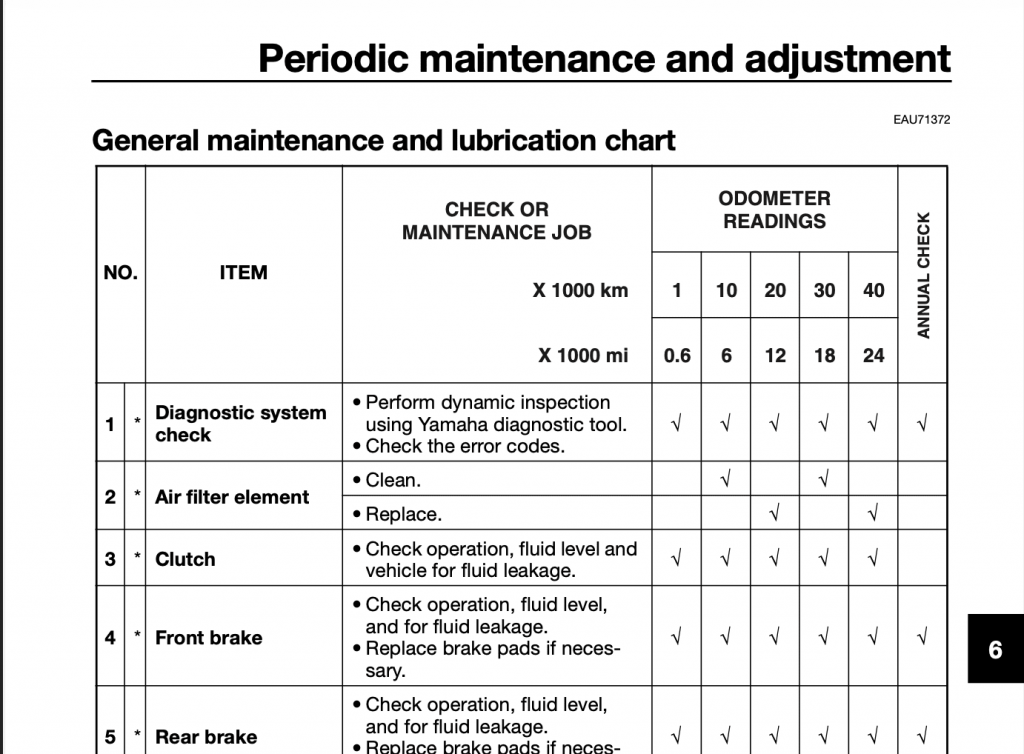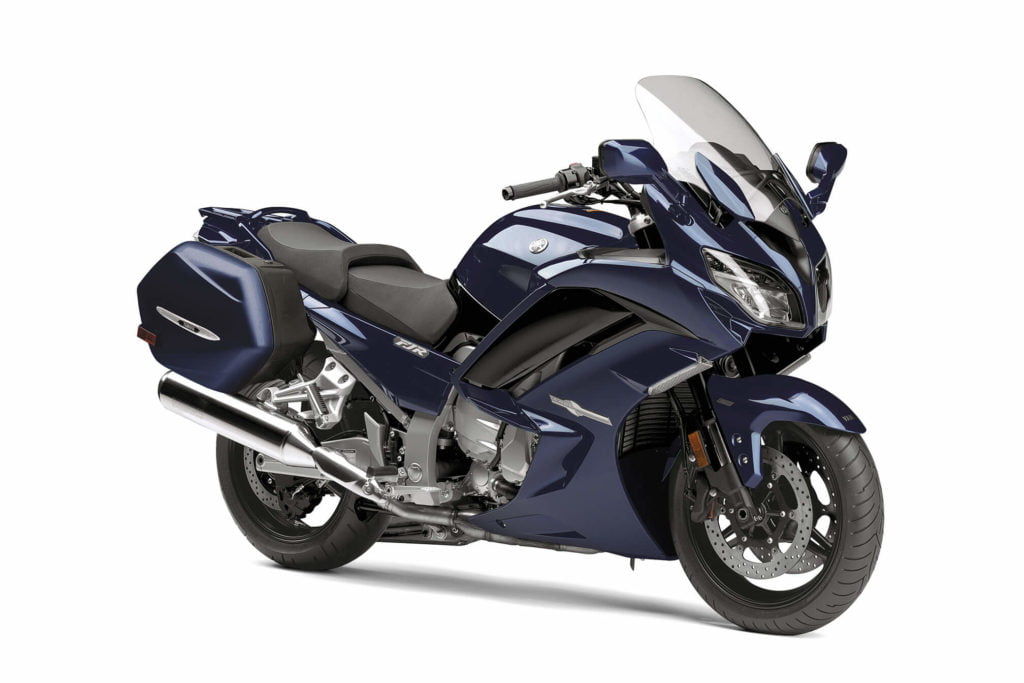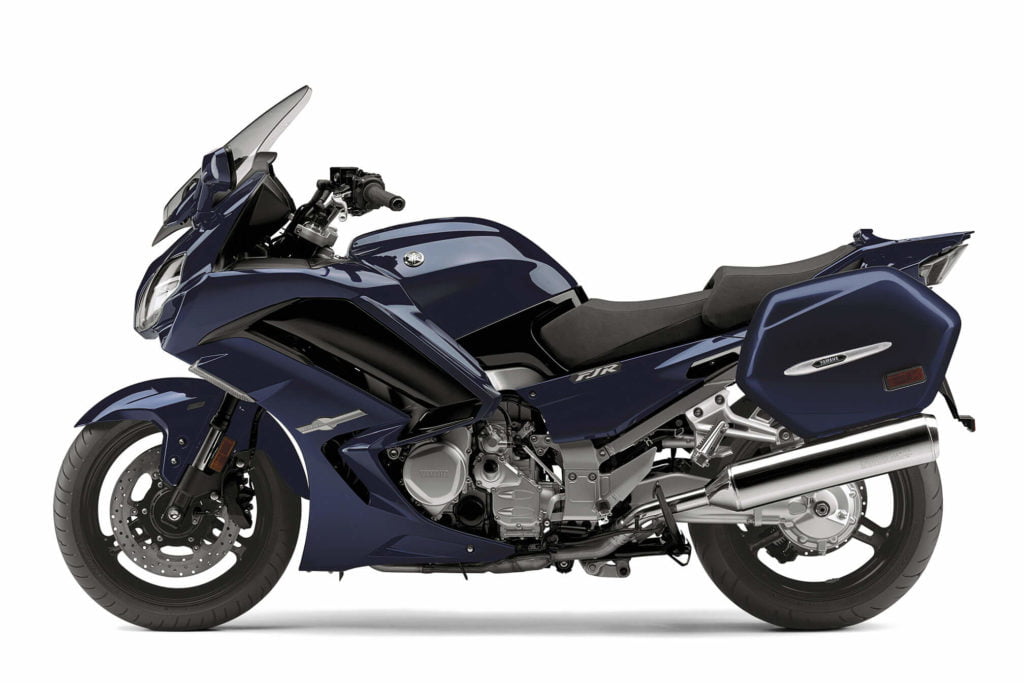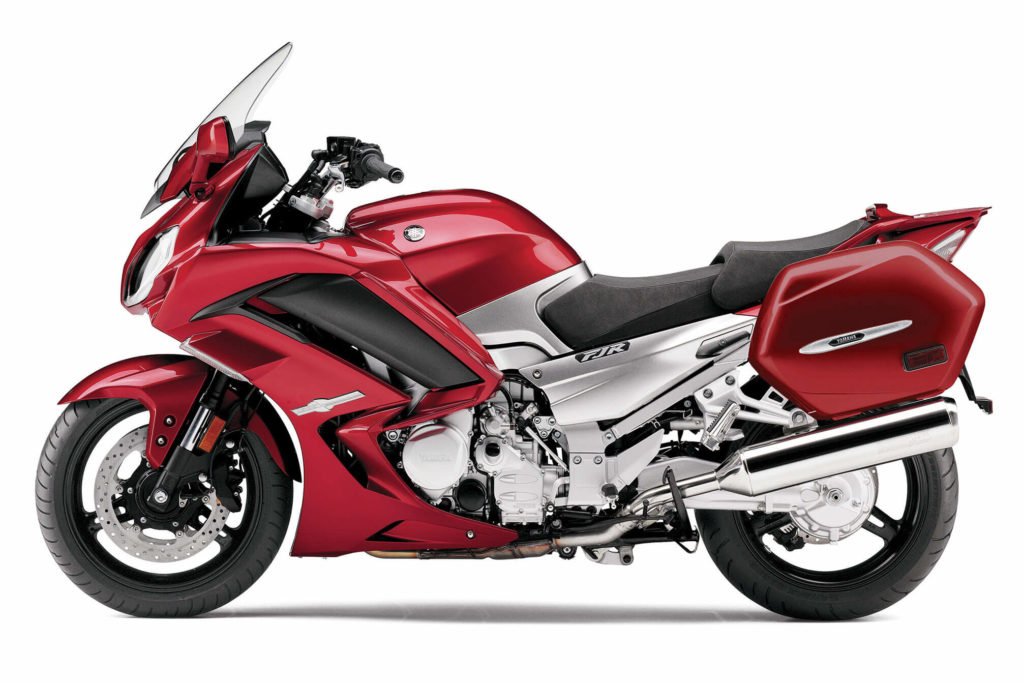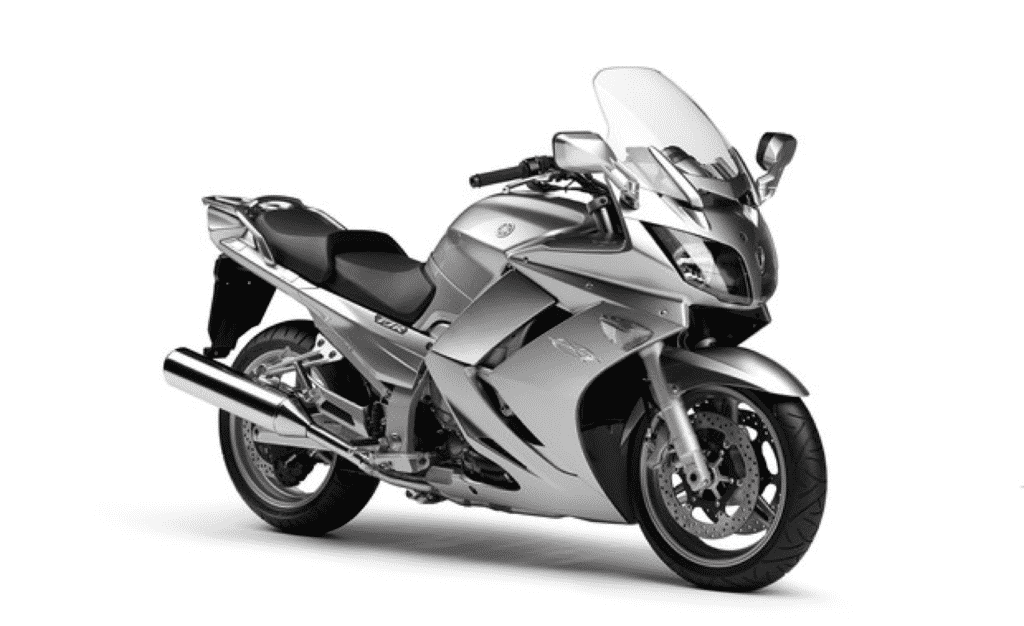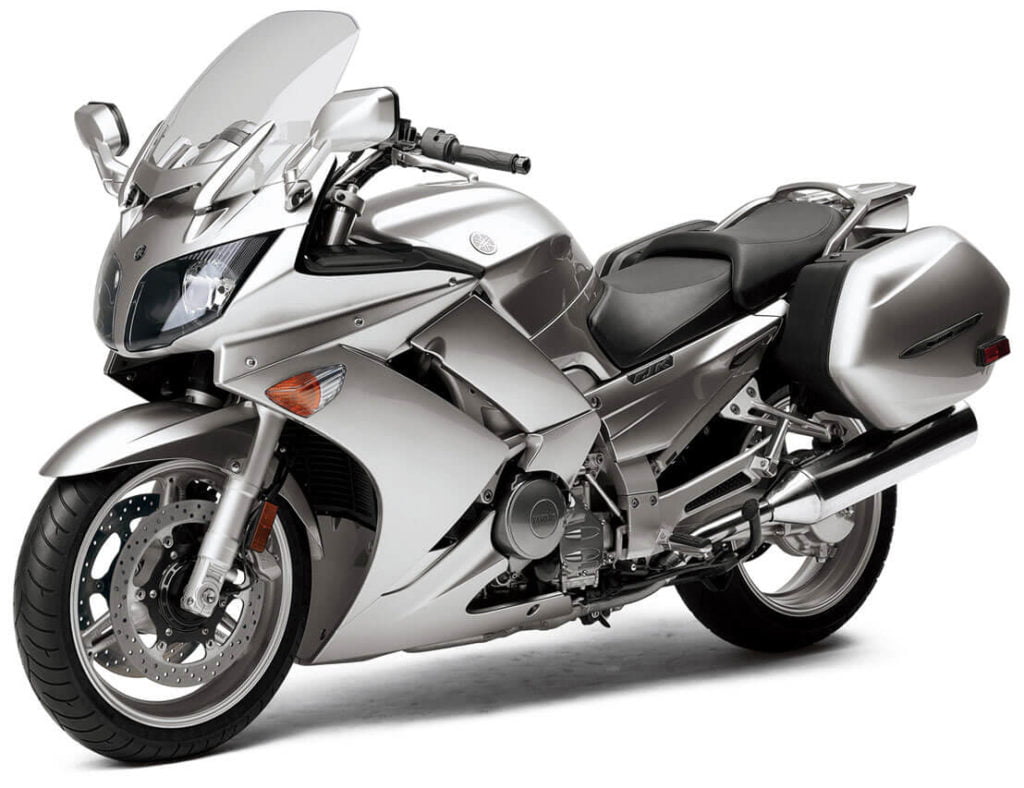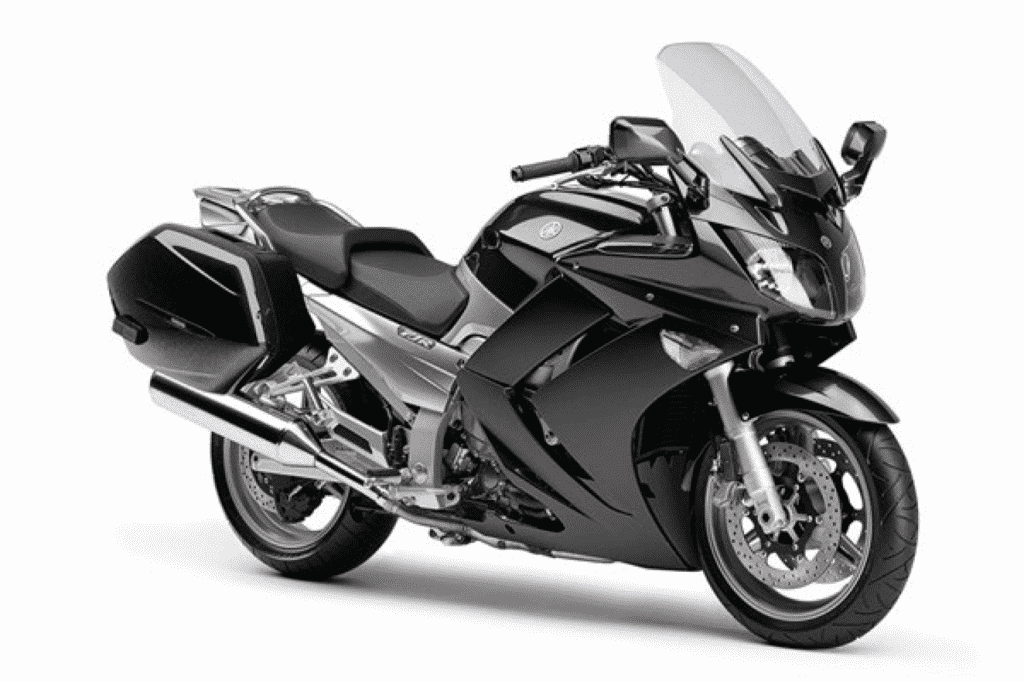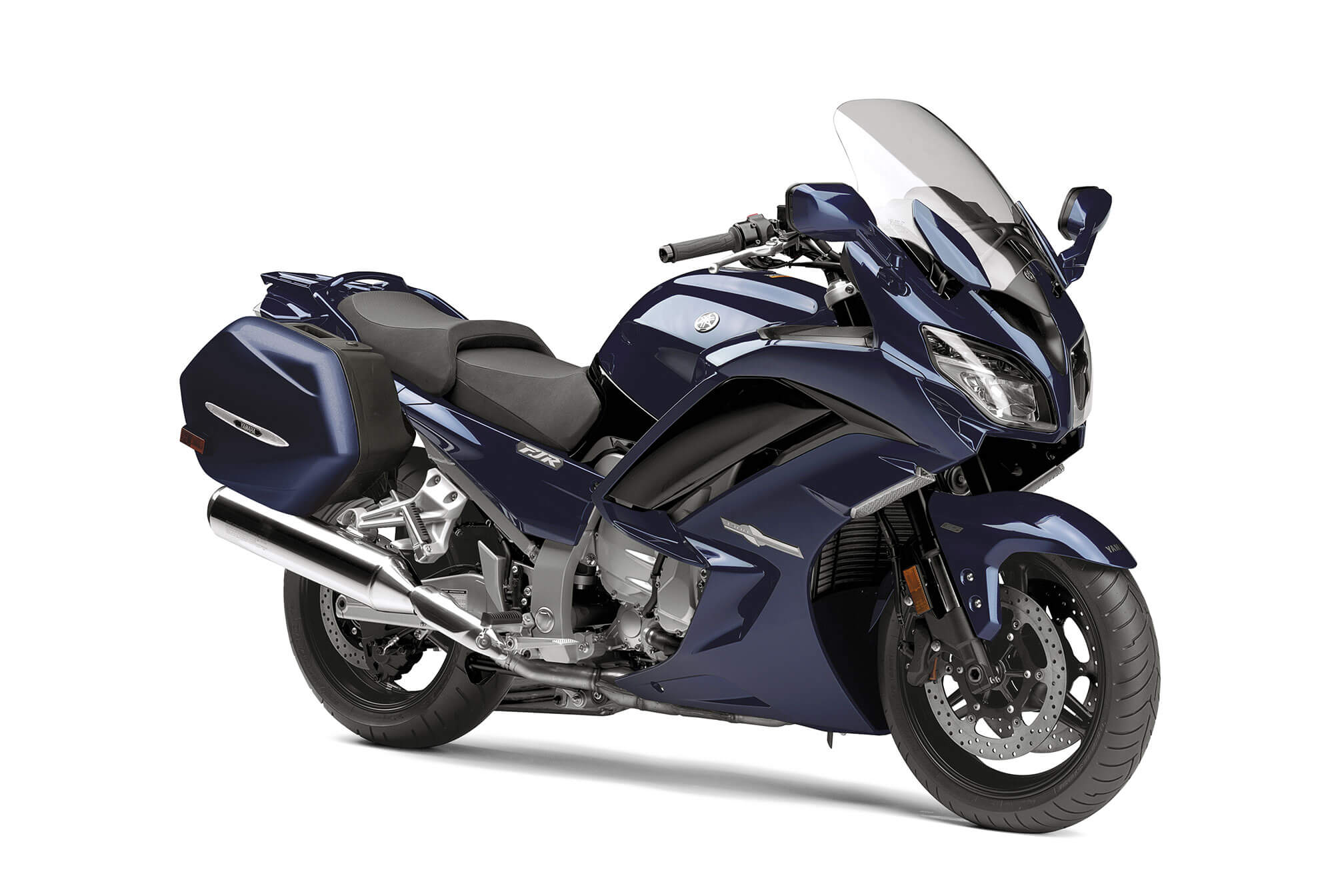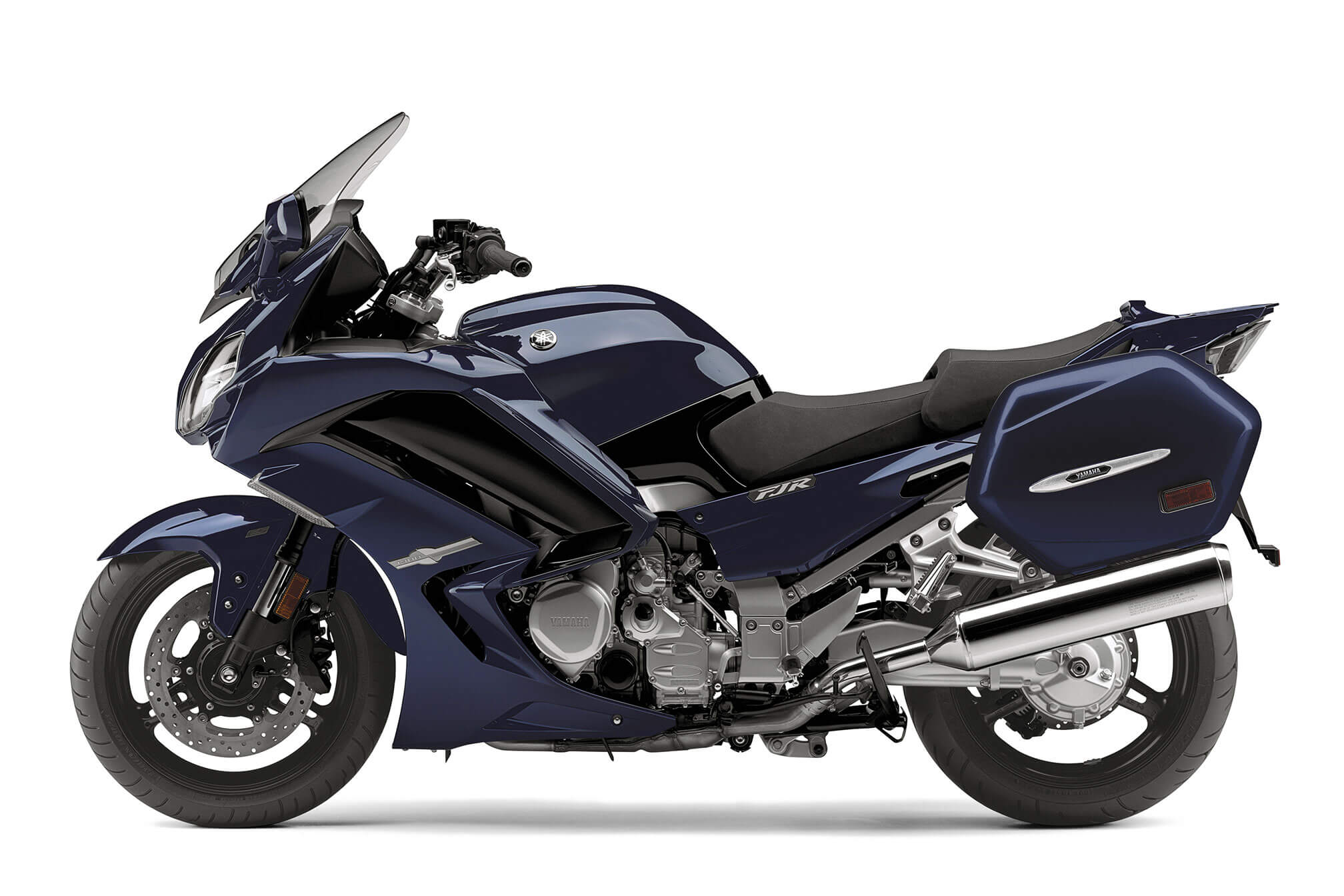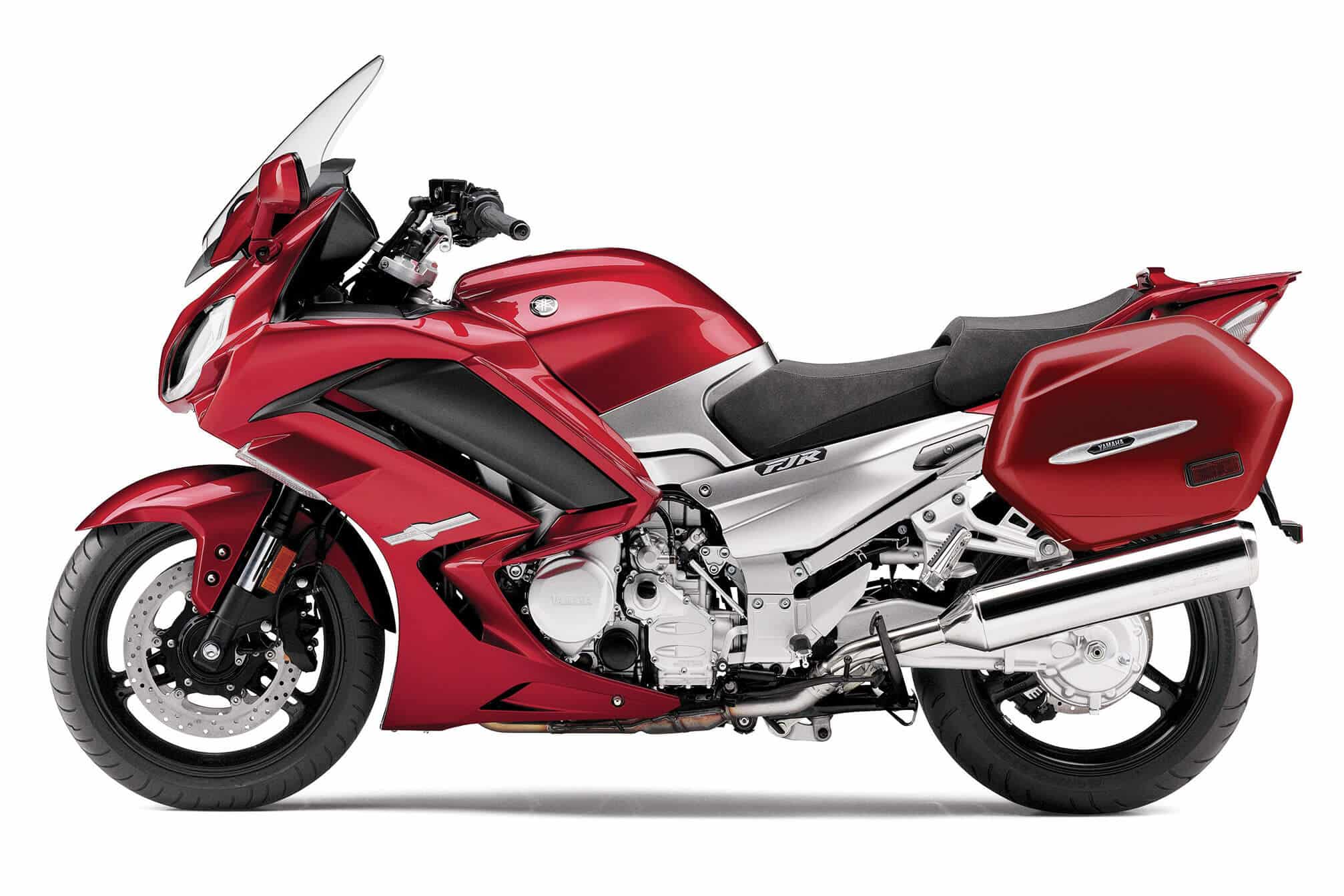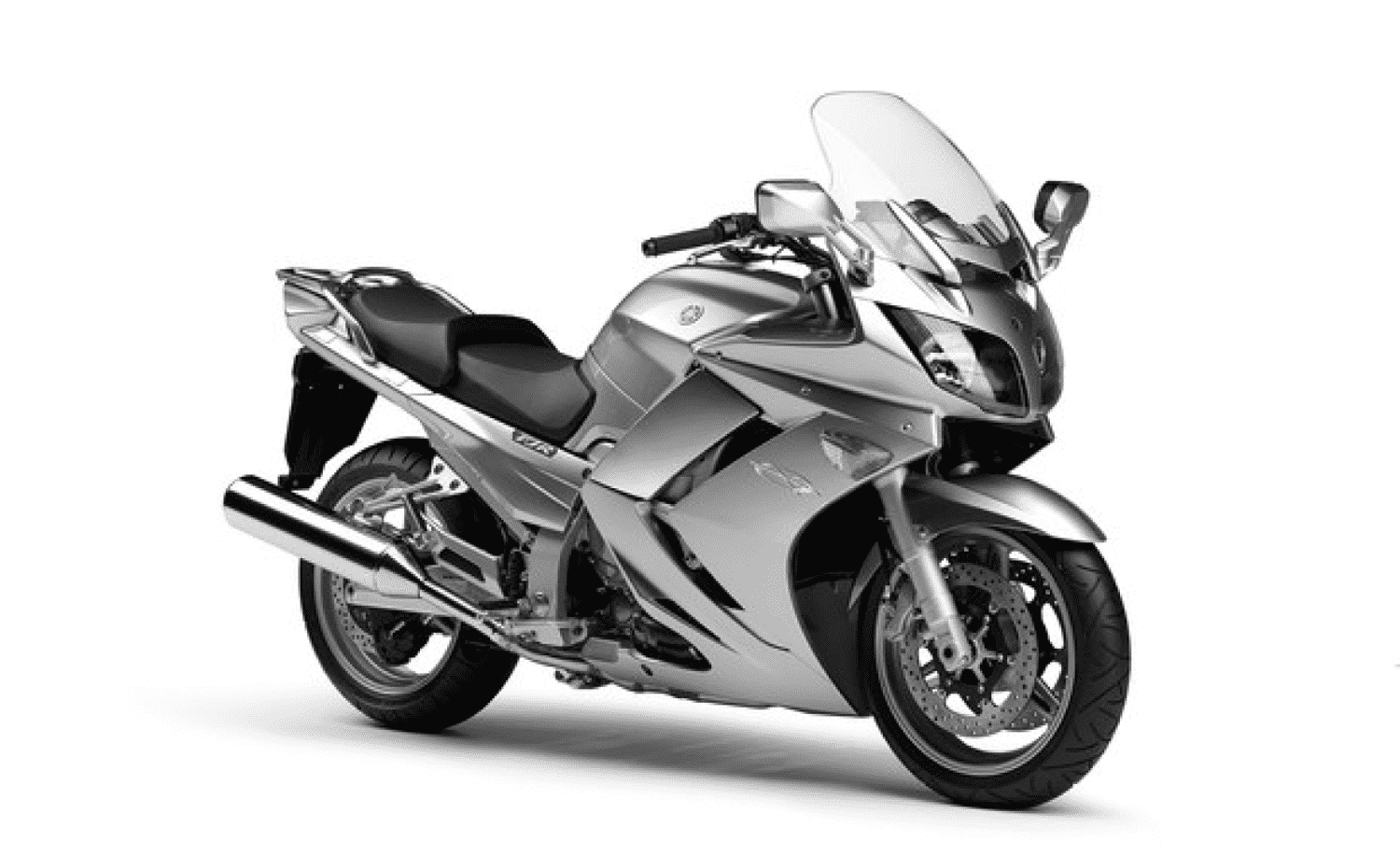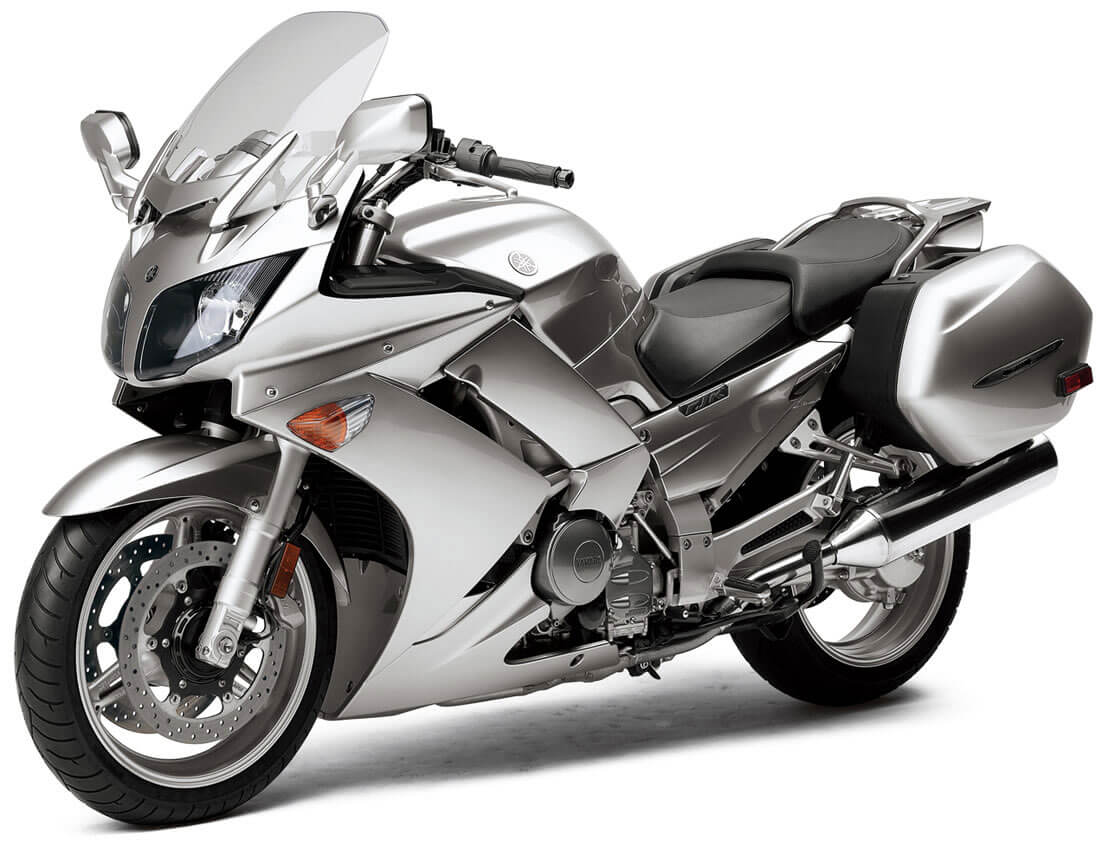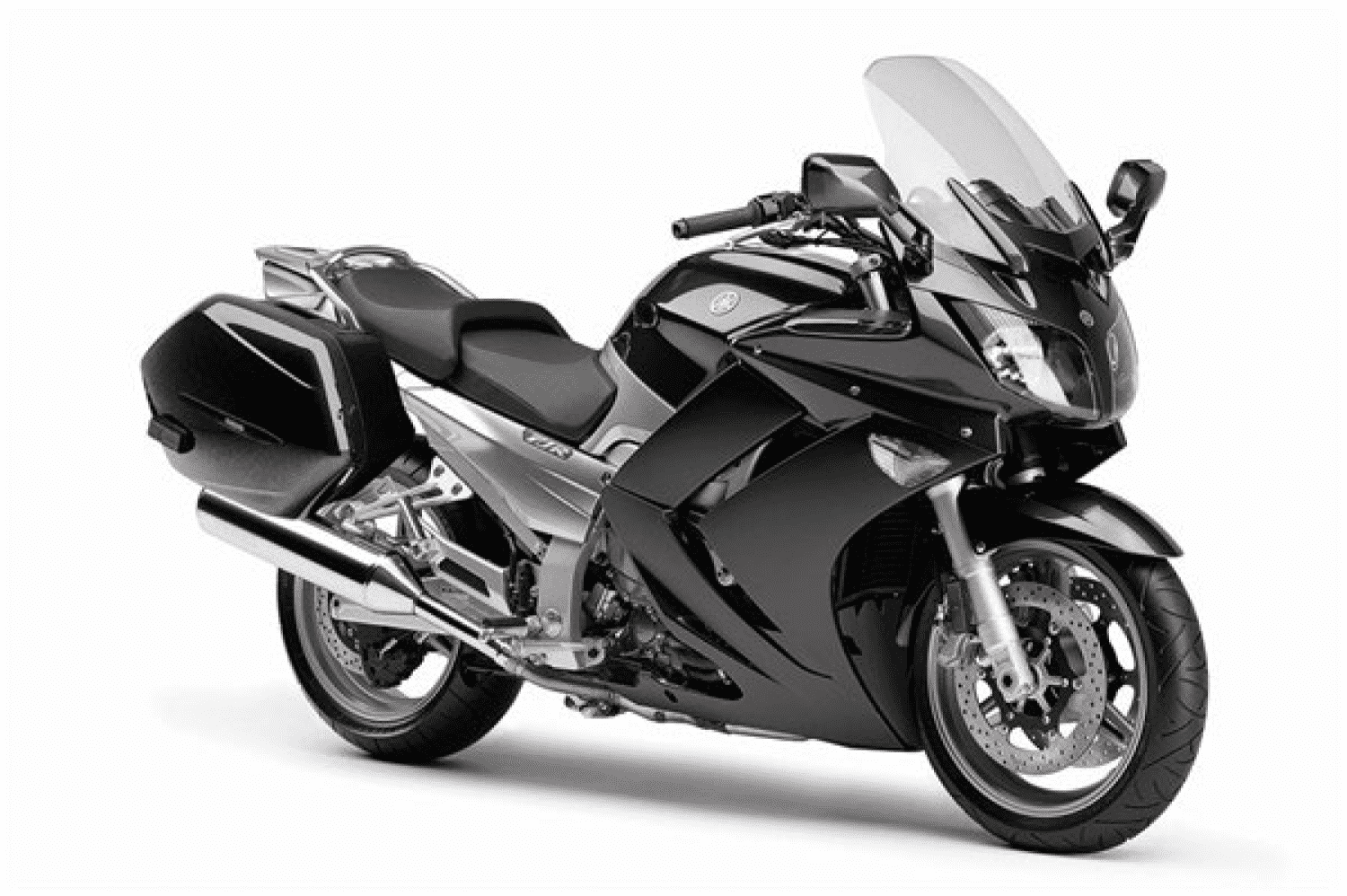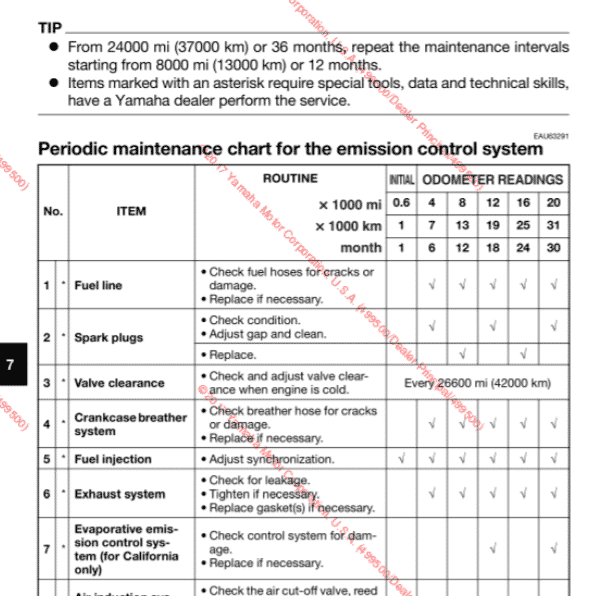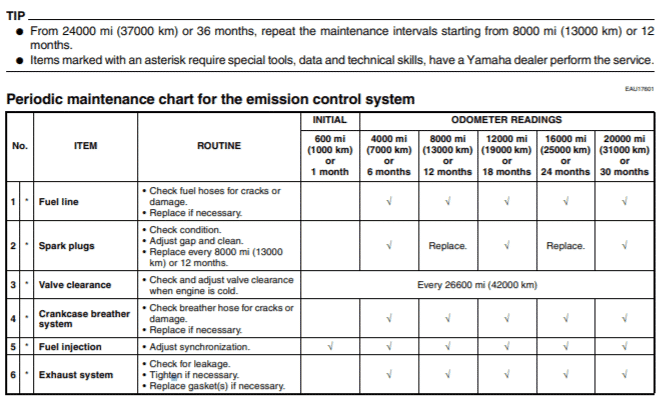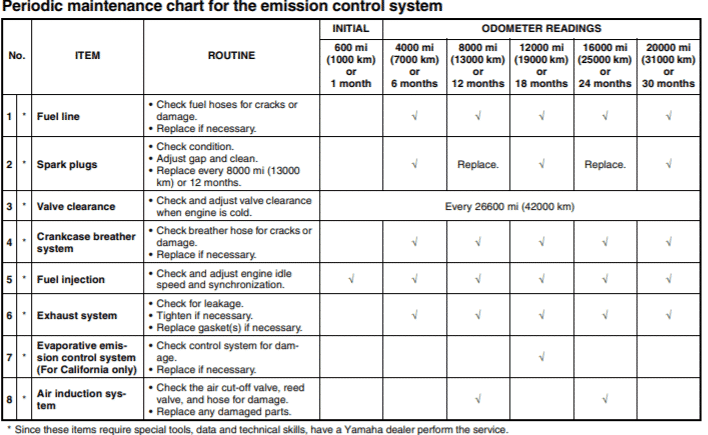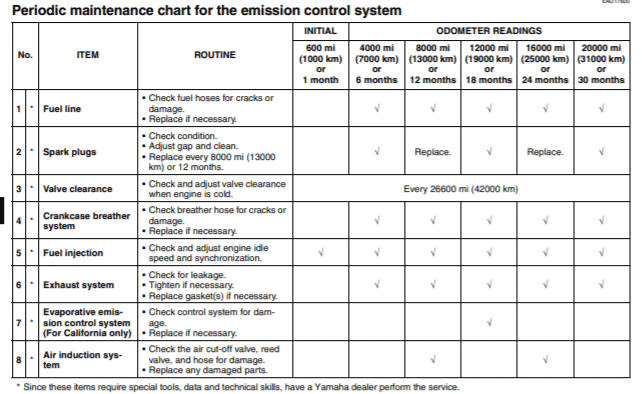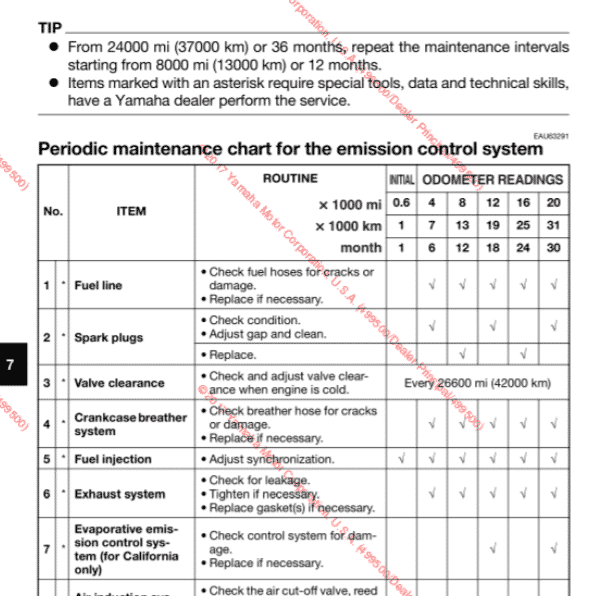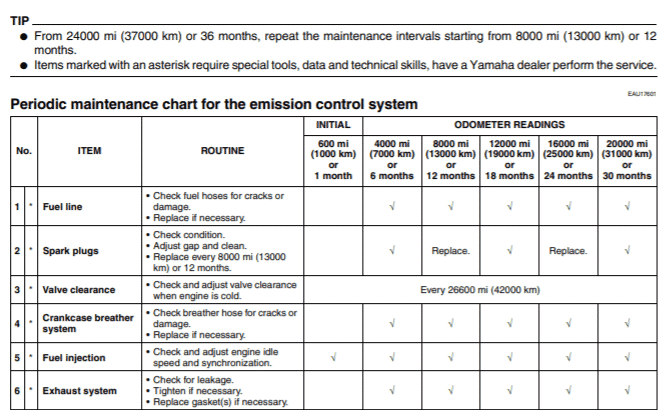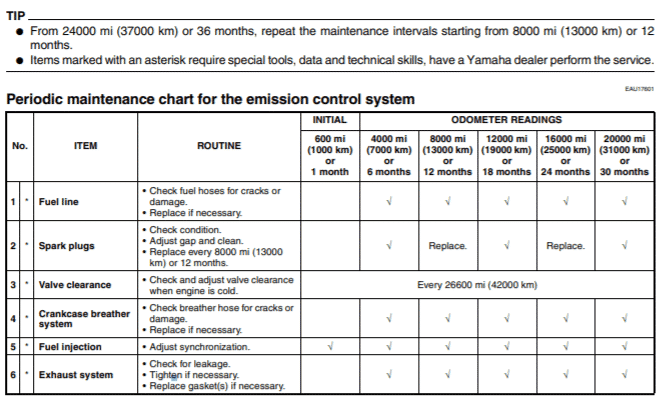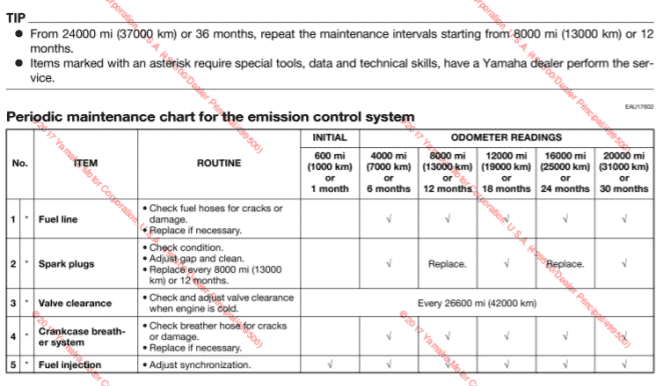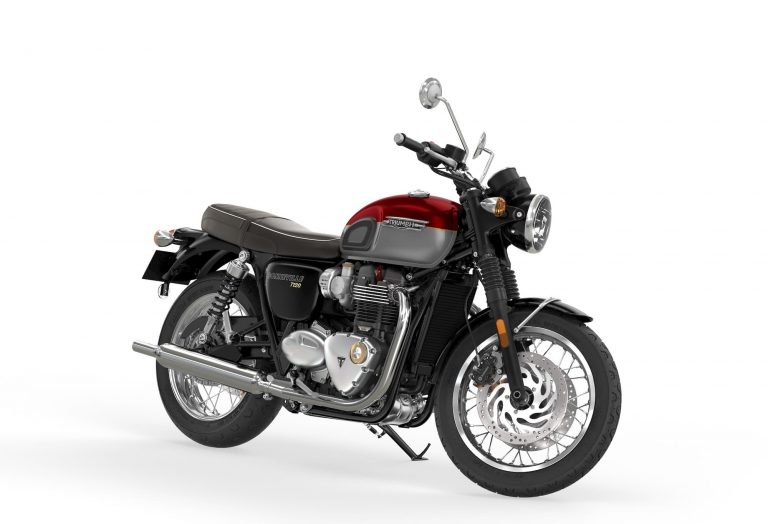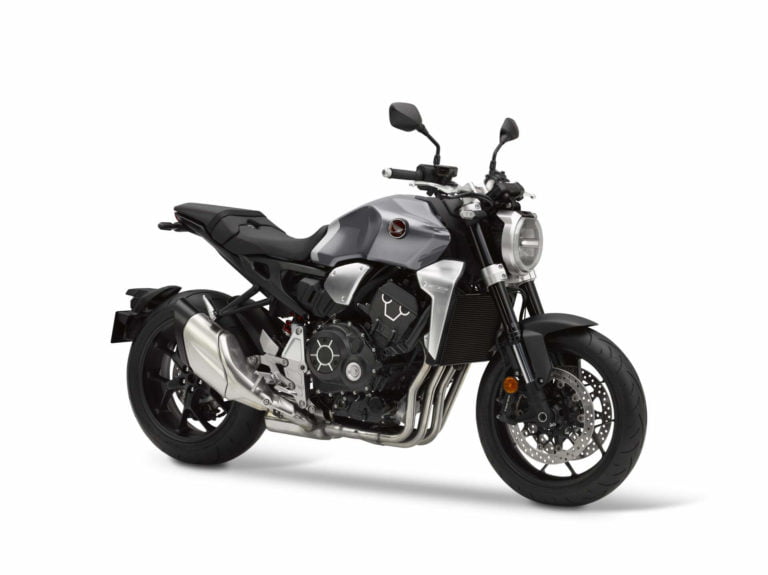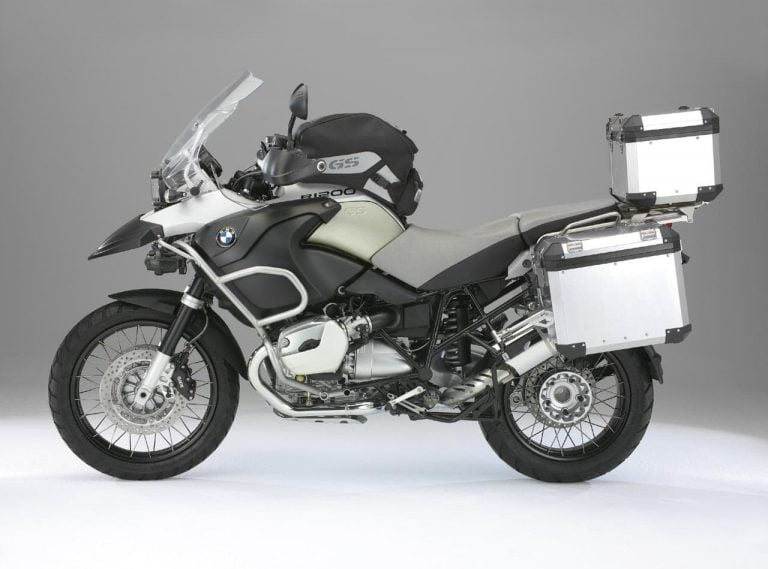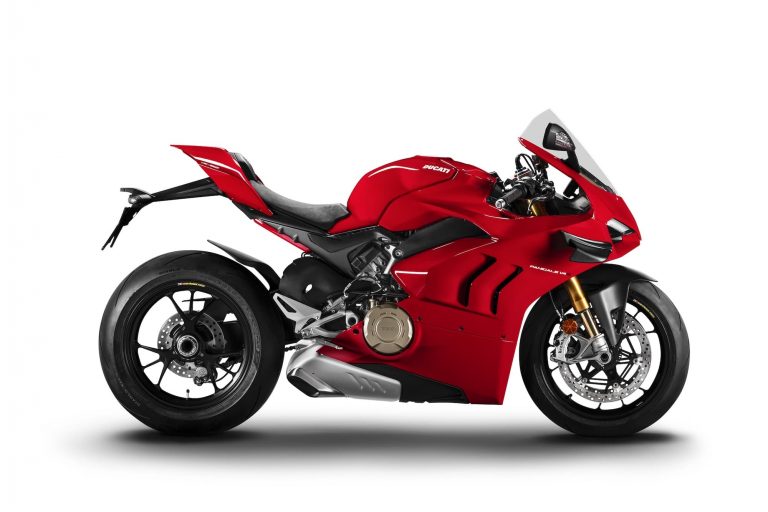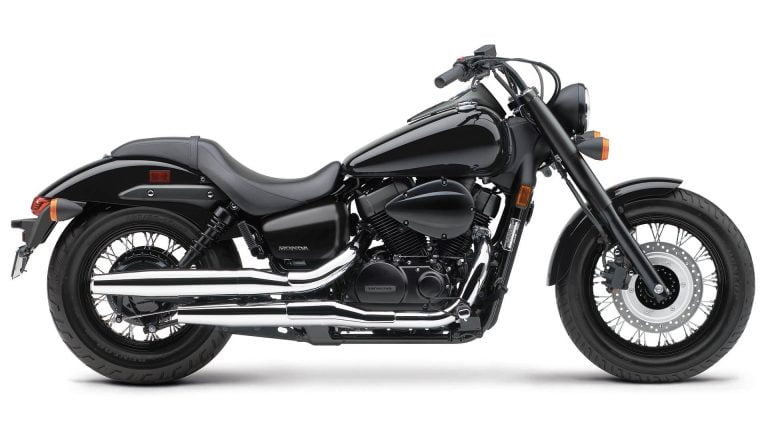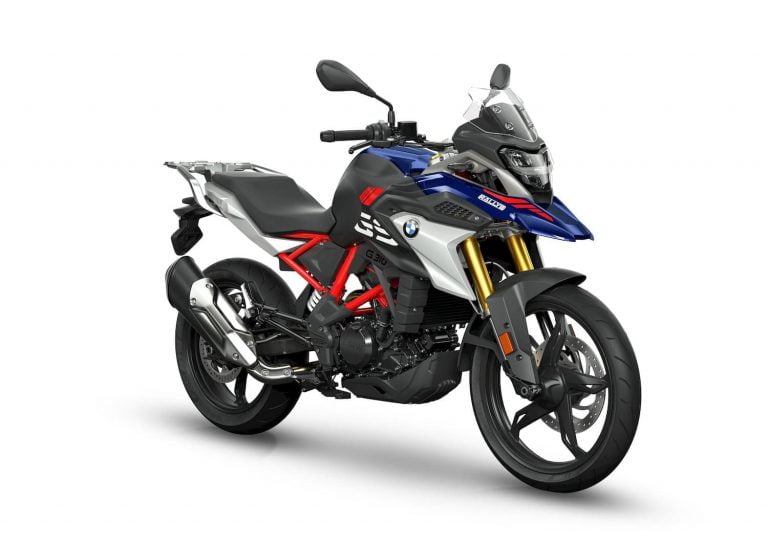Yamaha FJR1300 (2001-present, including AS, AE) Maintenance Schedule and Service Intervals
This is the maintenance schedule and associated service intervals for the Yamaha FJR1300.
The Yamaha FJR1300 is one of Yamaha’s big sports tourers. Yamaha has produced it since 2001 (though it hasn’t always been available in the US), always with a 1298cc inline four cylinder fuel injected engine.
The Yamaha FJR1300 It has always been a roughly 105 kW (140 hp) motorcycle making around 134 Nm (100 ft-lb) of torque at peak, pushing a somewhat heavy (~260 kg/~580 lb) chassis on a shaft drive. That much hasn’t changed in 20 years, so fundamentally, the service schedule for the early FJR is the same as today’s.
However there have been some generational changes worth mentioning:
- 1st generation FJR1300: Released in 2001
- 2nd generation FJR1300 (2004 in US, 2006 in the rest of the world) Braking improvements (note: different brake pads), with bigger 320mm discs (up from 298mm), and standard ABS from 2006. A few other rideability improvements like revised final drive ratio, curved radiator, instrumentation changes, upgraded alternator, and vents
- 2006: Semi-automatic transmission — known as the FJR1300AE in the US, and FJR1300AS in the rest of the world
- 2007-2012: Series of small updates, like throttle improvements, an ABS system change, and standard heated grips
- 2013: 3rd generation FJR1300: New bodywork, improved windshield, LED lighting, new dash. Higher spec automatic shift (ES in the US) model got electronic suspension and inverted front forks. The 3rd gen FJR also has engine improvements: cylinder lining that dissipates heat better, which led to a change of recommended engine oil spec. It also has a new ECU with YCCT (ride by wire), riding modes, traction control, and various other new controls.
- 2015: Six-speed transmission with new slipper/assist clutch, plus cornering lights
- 2021: Discontinued in Europe and the UK
Looking through the manuals for all the models, the maintenance schedule for all models of FJR1300 is nearly the same, apart from a mention to read computer error codes, from a later model.
Some parts change and they’re mentioned below.
Yamaha FJR1300 Service Intervals
General maintenance intervals for the FJR1300 in the US are a basic service (oil change) ever 4000 miles / 6000 km or 6 months, and a major valve service every 26600 miles or 42000 km.
At every oil change, you do need to look over the bike for leaks, or things that need replacement or lubrication.
In Europe and APAC (the Australia / Pacific region), the maintenance intervals are different for the FJR1300 — 10000 km or 6000 miles, and 12 months.
Also a few line items are different, or at least differently worded. This separate maintenance schedule is also below.
The Yamaha FJR1300 is powered by a shaft final drive, which at least means no annoying chain maintenance!
What you need to service the Yamaha FJR1300
If you’re servicing your own FJR, you need the following consumables, so here’s a little shopping list for you.
| Item | Yamaha FJR1300 spec |
|---|---|
| Spark Plug | NGK CR8E up to 2012, and NGK CPR8EA-9 for 2013+ 3rd gen |
| Air filter | Use a K&N YA-1301 |
| Front brake pads | 1st gen: EBC FA252HH 2nd gen onward: EBC FA423/4HH |
| Rear brake pads | EBC FA319/2HH (all generations) |
| Brake fluid | Castrol DOT 4 |
| Grease | Get some lithium soap-based grease and silicon grease |
| Engine oil filter | 1st and 2nd gen: Hiflofiltro HF148 3rd gen 2013+: Hiflofiltro HF204RC |
| Engine oil | 1st and 2nd gen (pre 2013): Yamalube 20W-40 or 20W-50 3rd gen (2013+) Yamalube 10W-40 or Yamalube 10W-50 |
| Coolant | Zerex G05 (an ethylene glycol antifreeze with corrosion inhibitors) |
On engine oil, earlier manuals specified 20W-40. But 10W-40 synthetic works for all motors.
Yamaha FJR1300A Maintenance Schedule
Below is the maintenance schedule for the Yamaha FJR1300. The maintenance schedule below is the same as in the manuals, but modified for ease of use. Where there’s a difference between years, it’s mentioned (but it’s very limited)
Tips for maintenance
- After the end of the schedule, continue in the pattern shown.
- If you’re unsure about any service items, take it to a dealer.
Yamaha FJR1300 — US / UK Maintenance Schedule (Miles)
Below is the maintenance schedule from the US manual with 4000 mile / 6 month service intervals.
| x1000 mi | 0.6 | 4 | 8 | 12 | 16 | 20 | |
|---|---|---|---|---|---|---|---|
| x1000 km | 1 | 7 | 13 | 19 | 25 | 31 | |
| Months | 1 | 6 | 12 | 18 | 24 | 30 | Every |
| Perform dynamic inspection using Yamaha diagnostic tool (2016+ models). Check the error codes | ✓ | ✓ | ✓ | ✓ | ✓ | ✓ | |
| Change engine oil (warm engine before draining), use Yamalube 10W-40 or Yamalube 10W-50 | ✓ | ✓ | ✓ | ✓ | ✓ | ✓ | |
| Replace oil filter (1st and 2nd gen: HF148, 3rd gen: HF204RC). | ✓ | ✓ | ✓ | ||||
| Clean air filter with compressed air. Replace if necessary (YA-1301) | ✓ | ✓ | ✓ | ✓ | ✓ | More often if riding in dusty / wet areas | |
| Check spark plug condition. Adjust gap (0.7-0.8mm with gapping tool) and clean. | ✓ | ✓ | ✓ | ||||
| Replace spark plugs (CR8E for Gen up to 2012, CPR8EA-9 for 2013 onward) | ✓ | ✓ | |||||
| Check and adjust valve clearance when engine is cold | 26600 mi (42000 km) | ||||||
| Check fuel lines for cracks or damage. Replace if necessary. | ✓ | ✓ | ✓ | ✓ | ✓ | ||
| Adjust fuel injection synchronization | ✓ | ✓ | ✓ | ✓ | ✓ | ✓ | |
| Check clutch (if non-auto) for operation, fluid level, and for fluid leakage. Correct if necessary | ✓ | ✓ | ✓ | ✓ | ✓ | ✓ | |
| Check front brake operation, fluid level, and for fluid leakage. Replace brake pads if necessary (Gen 1: EBC FA252HH, Gen 2+: EBC FA423/4HH) | ✓ | ✓ | ✓ | ✓ | ✓ | ✓ | |
| Check rear brake operation, fluid level, and for fluid leakage. Replace brake pads if necessary (EBC FA319/2HH) | ✓ | ✓ | ✓ | ✓ | ✓ | ✓ | |
| Check brake hoses for cracks or damage. Check for correct routing and clamping | ✓ | ✓ | ✓ | ✓ | ✓ | ||
| Replace brake hoses | 4 years | ||||||
| Change brake fluid (Castrol DOT 4) and rubber parts of brake calipers & master cylinder | 2 years | ||||||
| Check cooling system hoses for cracks or damage. Replace if necessary | ✓ | ✓ | ✓ | ✓ | ✓ | ||
| Replace coolant | ✓ | ||||||
| Check final gear oil level for oil leakage | ✓ | ||||||
| Change final gear oil | ✓ | ✓ | |||||
| Check wheels for runout and for damage. Replace if necessary | ✓ | ✓ | ✓ | ✓ | ✓ | ||
| Check tyre tread depth and for damage. Replace if necessary | ✓ | ✓ | ✓ | ✓ | ✓ | ||
| Check wheel bearings for smooth operation. Replace if necessary | ✓ | ✓ | ✓ | ✓ | ✓ | ||
| Check swingarm pivot bearings bearing assembly for looseness | ✓ | ||||||
| Moderately repack swingarm pivot bearings with lithium-soap-based grease | ✓ | ||||||
| Check steering bearing assembly for looseness | ✓ | ✓ | ✓ | ✓ | ✓ | ✓ | |
| Moderately repack steering bearing with lithium-soap-based grease | ✓ | 16000 miles / 25000 km | |||||
| Check all chassis fittings and fasteners. Correct if necessary | ✓ | ✓ | ✓ | ✓ | ✓ | ||
| Lubricate brake lever with silicone grease lightly | ✓ | ✓ | ✓ | ✓ | ✓ | ||
| Lubricate brake pedal, clutch lever, and shift pedal with lithium soap-based grease lightly | ✓ | ✓ | ✓ | ✓ | ✓ | ||
| Check center and side stand operation. Apply lithium soap-based grease lightly | ✓ | ✓ | ✓ | ✓ | ✓ | ||
| Check side stand switch operation and replace if necessary | ✓ | ✓ | ✓ | ✓ | ✓ | ✓ | |
| Check front fork operation and for oil leakage. Rebuild / Replace if necessary. | ✓ | ✓ | ✓ | ✓ | ✓ | ||
| Check shock absorber operation and for oil leakage. Replace if necessary. | ✓ | ✓ | ✓ | ✓ | ✓ | ||
| Lubricate rear suspension link pivots with lithium soap-based grease lightly | ✓ | ||||||
| Check front and rear brake switch operation | ✓ | ✓ | ✓ | ✓ | ✓ | ✓ | |
| Lubricate control cables thoroughly (Protect All Cable Life) | ✓ | ✓ | ✓ | ✓ | ✓ | ✓ | |
| Check throttle grip operation and free play. Adjust if necessary. Lubricate cable and grip housing, and grip warmer wire | ✓ | ✓ | ✓ | ✓ | ✓ | ||
| Check lights, signals, and switches. Adjust headlight beam. | ✓ | ✓ | ✓ | ✓ | ✓ | ✓ | |
| Check crankcase breather hose for cracks or damage. Replace if necessary. | ✓ | ✓ | ✓ | ✓ | ✓ | ||
| Check the air cut-off valve, reed valve, and hose for damage. Replace any damaged parts | ✓ | ✓ | |||||
| Check exhaust system for leakage. Tighten and/or replace gaskets if necessary. | ✓ | ✓ | ✓ | ✓ | ✓ | ||
| Check evap control system (if fitted) for damage. Replace if necessary. | ✓ | ✓ |
Yamaha FJR1300 — Europe / APAC maintenance schedule
Below is the maintenance schedule from the Europe / Asia-Pacific manuals in km, with 10000 km / 12 month service intervals.
See here for more information on how the Yamaha US/Europe manuals differ.
Note many items are marked “Year” — these should be done as part of the annual service.
| x1000 km | 1 | 10 | 20 | 30 | 40 | |
|---|---|---|---|---|---|---|
| x1000 mi | 0.6 | 6 | 12 | 18 | 24 | Every |
| Perform dynamic inspection using Yamaha diagnostic tool (2016+ models). Check the error codes | ✓ | ✓ | ✓ | ✓ | ✓ | Year |
| Change engine oil (warm engine before draining), use Yamalube 10W-40 or Yamalube 10W-50 | ✓ | ✓ | ✓ | ✓ | ✓ | |
| Replace oil filter (1st and 2nd gen: HF148, 3rd gen: HF204RC). | ✓ | ✓ | ✓ | |||
| Check and clean air filter. Replace if necessary (YA-1301) | ✓ | ✓ | More often if riding in dusty / wet areas | |||
| Replace air filter (YA-1301) | ✓ | ✓ | ||||
| Check spark plug condition. Adjust gap (0.7-0.8mm with gapping tool) and clean. | ✓ | ✓ | ||||
| Replace spark plugs (CR8E for Gen up to 2012, CPR8EA-9 for 2013 onward) | ✓ | ✓ | ||||
| Adjust fuel injection synchronization | ✓ | ✓ | ✓ | ✓ | ✓ | |
| Check and adjust valve clearance when engine is cold | 40000 km (24000 mi) | |||||
| Check fuel lines for cracks or damage. Replace if necessary. | ✓ | ✓ | ✓ | ✓ | ||
| Check clutch (if non-auto) for operation, fluid level, and for fluid leakage. Correct if necessary | ✓ | ✓ | ✓ | ✓ | ✓ | |
| Check front brake operation, fluid level, and for fluid leakage. Replace brake pads if necessary (Gen 1: EBC FA252HH, Gen 2+: EBC FA423/4HH) | ✓ | ✓ | ✓ | ✓ | ✓ | Year |
| Check rear brake operation, fluid level, and for fluid leakage. Replace brake pads if necessary (EBC FA319/2HH) | ✓ | ✓ | ✓ | ✓ | ✓ | Year |
| Check brake hoses for cracks or damage. Check for correct routing and clamping | ✓ | ✓ | ✓ | ✓ | Year | |
| Replace brake hoses | 4 years | |||||
| Change brake fluid (Castrol DOT 4) and rubber parts of brake calipers & master cylinder | 2 years | |||||
| Check cooling system hoses for cracks or damage. Replace if necessary | ✓ | ✓ | ✓ | ✓ | Year | |
| Replace coolant | 3 years | |||||
| Change final gear oil, and inspect vehicle for leakage. | ✓ | ✓ | ✓ | ✓ | ✓ | |
| Check steering bearing assembly for looseness | ✓ | ✓ | ✓ | |||
| Moderately repack steering bearing with lithium-soap-based grease | ✓ | ✓ | ||||
| Check swingarm pivot bearings for excessive play | ✓ | ✓ | ✓ | ✓ | ||
| Lubricate swingarm bearing with lithium soap-based grease Note: Not mentioned in recent manuals | 50000 km (30000 mi) | |||||
| Check relay suspension arm and connecting pivot points for looseness | ✓ | ✓ | ✓ | ✓ | ||
| Moderately lubricate relay suspension arm / connecting pivot points with lithium soap-based grease | ✓ | ✓ | ||||
| Check wheels for runout and for damage. Replace if necessary | ✓ | ✓ | ✓ | ✓ | ||
| Check tyre tread depth and for damage. Replace if necessary | ✓ | ✓ | ✓ | ✓ | Year | |
| Check wheel bearings for looseness or damage. Replace if necessary | ✓ | ✓ | ✓ | ✓ | ||
| Check all chassis fittings and fasteners. Correct if necessary | ✓ | ✓ | ✓ | ✓ | Year | |
| Lubricate brake lever with silicone grease lightly | ✓ | ✓ | ✓ | ✓ | Year | |
| Lubricate brake pedal, clutch lever, and shift pedal with lithium soap-based grease lightly | ✓ | ✓ | ✓ | ✓ | Year | |
| Check center and side stand operation. Apply lithium soap-based grease lightly | ✓ | ✓ | ✓ | ✓ | Year | |
| Check side stand switch operation and replace if necessary | ✓ | ✓ | ✓ | ✓ | ✓ | Year |
| Check front fork operation and for oil leakage. Rebuild / Replace if necessary. | ✓ | ✓ | ✓ | ✓ | ||
| Check shock absorber operation and for oil leakage. Replace if necessary. | ✓ | ✓ | ✓ | ✓ | ||
| Check front and rear brake switch operation | ✓ | ✓ | ✓ | ✓ | ✓ | Year |
| Lubricate moving parts and control cables thoroughly (Protect All Cable Life) | ✓ | ✓ | ✓ | ✓ | ✓ | Year |
| Check throttle grip operation and free play. Adjust if necessary. Lubricate cable and grip housing, and grip warmer wire (Protect all cable life) | ✓ | ✓ | ✓ | ✓ | Year | |
| Check lights, signals, and switches. Adjust headlight beam. | ✓ | ✓ | ✓ | ✓ | ✓ | Year |
| Check crankcase breather hose for cracks or damage. Replace if necessary. | ✓ | ✓ | ✓ | ✓ | ||
| Check the air induction cut-off valve, reed valve, and hose for damage. Replace any damaged parts | ✓ | ✓ | Year | |||
| Check exhaust system for leakage. Tighten and/or replace gaskets if necessary. | ✓ | ✓ | ✓ | ✓ |
About the Yamaha FJR1300
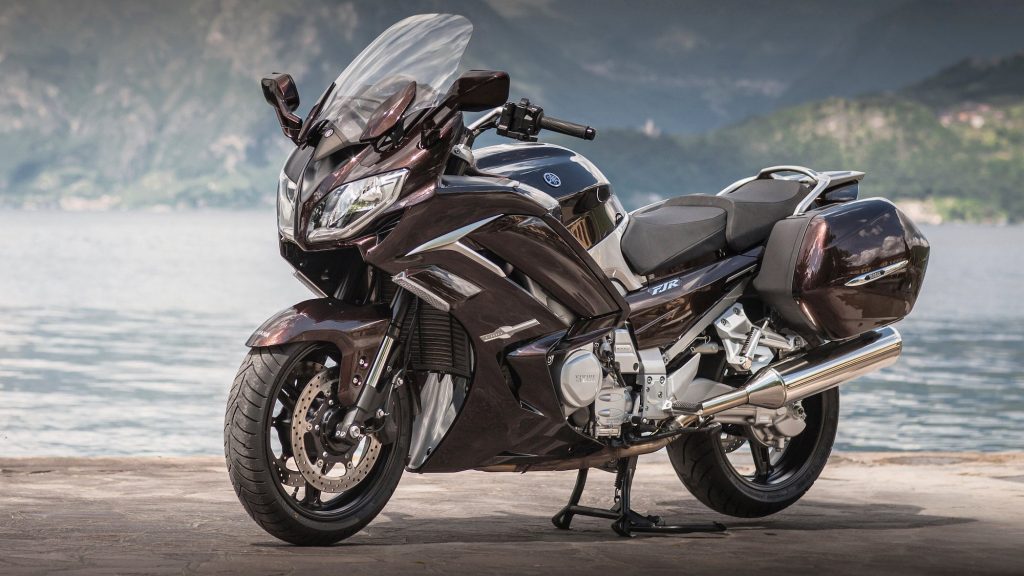
The Yamaha FJR1300 is one of the most iconic sport touring bikes of the last few decades, and the one with the longest production cycle, thanks to the support from many police departments around the world.
It’s a sport touring motorcycle that people describe as “actually fast”, on top of being very comfortable, and rock-solid reliable. That’s why it’s one of the most common choices for a police or escort bike in many countries, along with the Honda ST1300 and BMW R 1200 RT.
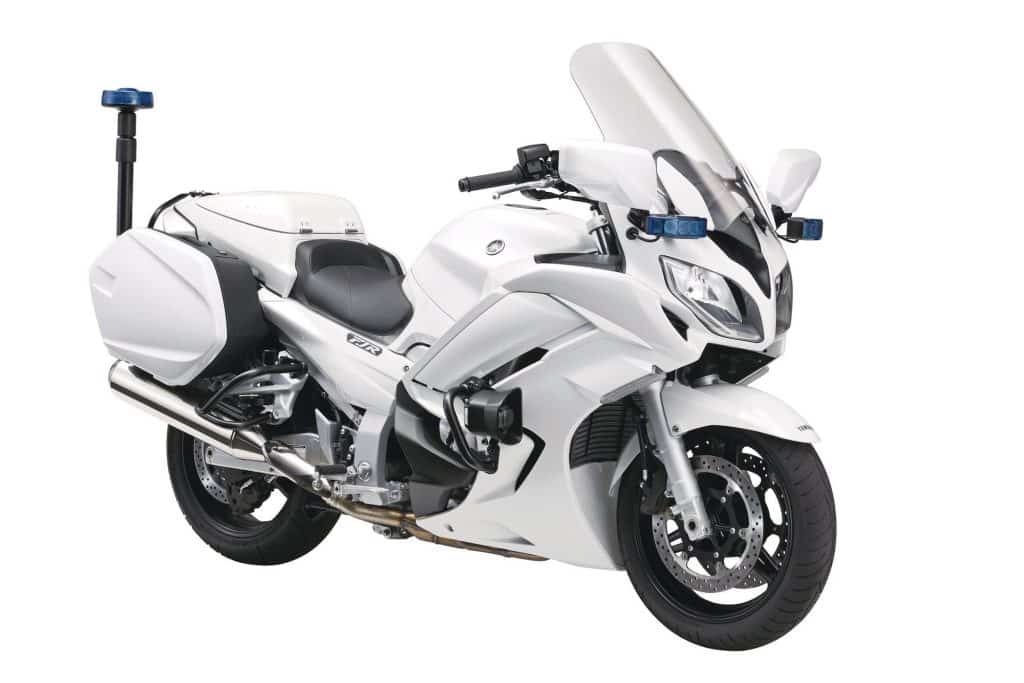
Since its launch, the Yamaha FJR1300 has had a 1298cc DOHC 16-valve liquid-cooled transversely mounted inline four cylinder engine. In the early days it had a five speed gearbox, but Yamaha updated this in 2015.
The high power comes despite the relaxed 10.8:1 compression ratio that means the FJR doesn’t depend on premium petrol.
Yamaha has improved the FJR1300 along the way with many incremental changes, though none of them ever changed the base motor fundamentally. In 2013, though, Yamaha did improve the internals of the FJR1300’s inline four, giving it better heat dissipation on in the cylinders. This didn’t affect the maintenance schedule, however.
The Yamaha FJR1300 has come in a number of specs over the years, adding niceties like ABS and electronic suspension with inverted forks along the way in some models. The nomenclature is a bit different between regions, so this isn’t the place to mention it; suffice it to say that you can usually opt between electronic suspension (the more expensive version, obviously) and non-electronic suspension.
Possibly because of its longevity, the Yamaha FJR1300 is the least expensive high-spec sport tourer on the market. And because it’s a popular fleet motorcycle, the FJR1300 has tried to keep most of its specs the same, for ease and affordability of maintenance, especially as these bikes are often ridden very hard by police departments — just ask any shop that services police bikes!
So while the Yamaha FJR1300 even in its highest spec has things like heated grips, an electronically adjustable windscreen, and cruise control, it still lacks cornering ABS, which has even made it onto the middleweight sport tourer, the Yamaha Tracer 9 GT.
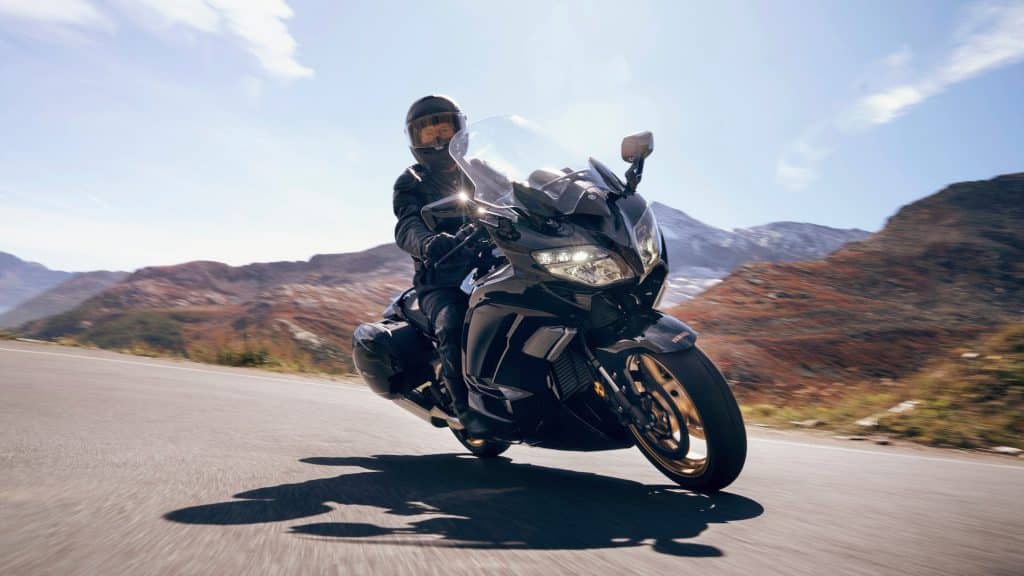
The Yamaha FJR1300 is, alas, a dying category of motorcycle. These days, sport touring bikes are more styled as “adventure sport touring”, and the middleweight range of bikes is the fastest growing — perhaps in part due to rising fuel prices.
But the FJR1300 is properly a sportbike, even though it’s very comfortable. Yes, it’s heavy, but not prohibitively so; the torque and power will take you to north of 150 mph or 220 km/h as you need it.
One less-often discussed aspect of the Yamaha FJR1300 is the semi-automatic transmission. It’s not an automatic, but rather needs to be fired. It’s up to you, the user, to use either handlebar switches or clutch pedals to shift.
Models equipped with the clutchless shifter don’t even have a clutch lever. You don’t need it! (Nor do you need to lube the clutch cable!)
You might think “I won’t give up shifting with my feet!”. And indeed, if you’re someone who likes the visceral, slightly complicated nature of riding most motorcycles, then maybe the FJR1300 isn’t for you. But your left foot will become unemployed, and in time, relaxed.
Speaking of pedals, the FJR1300 also has unified braking. This means that if you use the front lever, the rear brakes will also activate, and if you use the brake pedal, some of the front brakes will also activate. You have to use both the pedal and lever for full braking, but that’s probably only for quite extreme situations.
Maintaining the Yamaha FJR1300 hasn’t changed dramatically over the 20+ years of its life. Basic oil changes are 4000 miles or 10000 km apart (whether in the US or Europe). And valve service intervals are every 26600 miles or 40000 km, again depending on whether you’re on one side of the pond or another.
Mostly, Yamaha FJR1300s are known for being near indestructible. People put 100000 km on them and then sell them for not as much of a discount as you’d think.
Manual for the Yamaha FJR1300
The above information was gleaned from the owner’s manual for the 2022 Yamaha FJR1300AE and 2020 Yamaha FJR1300 in Europe, with input from other manuals going back to 2003 in the US.
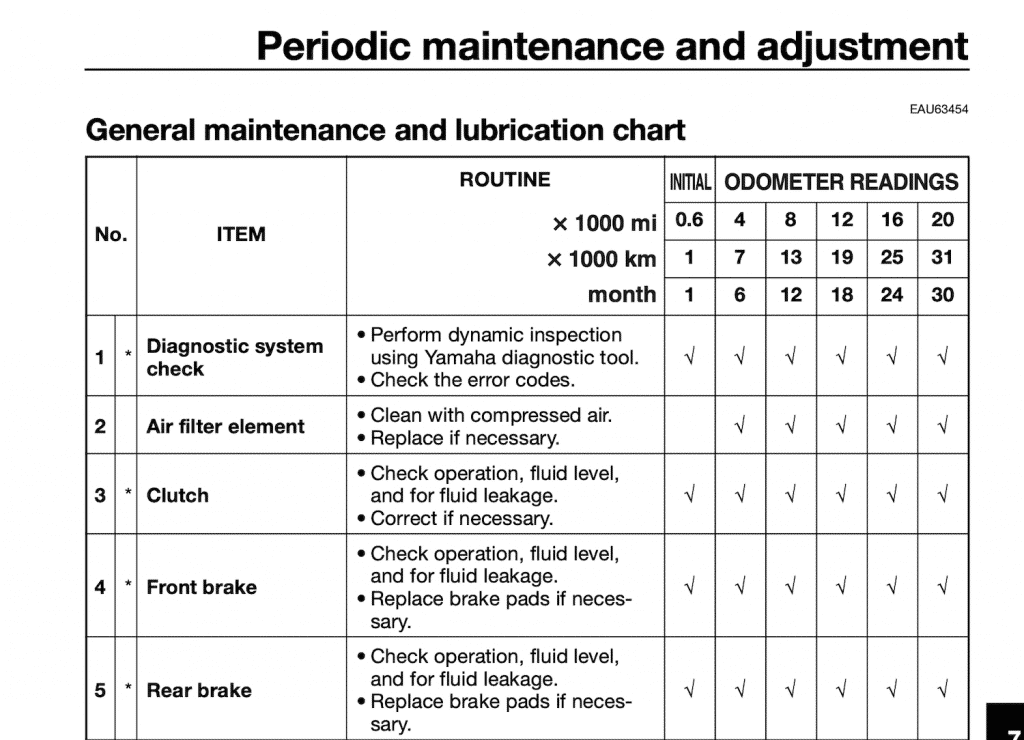
Below are some other maintenance schedules from the archives.
You can download it from Yamaha’s website in the US here.
The Europe/APAC maintenance schedule came from a different manual. See below — 10000 km maintenance service intervals.
